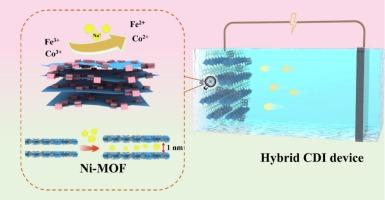Interface engineering of Ni-MOF/NiCoFe-Prussian blue analogue composite with enhanced Na+ storage kinetics for high-performance hybrid capacitive deionization
IF 6.9
2区 材料科学
Q2 CHEMISTRY, PHYSICAL
引用次数: 0
Abstract
Prussian blue faces challenges, including a tendency for particle agglomeration and limited charge transfer, which limit their application in hybrid capacitive deionization (CDI) technology. Herein, we develop a Ni-MOF/NiCoFe-Prussian blue analogue (NiCoFe-PBA) heterostructure by employing an in-situ growth of NiCoFe-PBA on a 2D Ni-MOF substrate. The formation of this heterogeneous interface significantly enhances charge transfer efficiency. Additionally, the in-situ growth of PBA on the MOF surface effectively mitigates the stacking of 2D Ni-MOF sheets, thereby increasing the exposure of active sites. Furthermore, Ni improves the structural stability of the composite during Na+ ion embedding/de-embedding, while Co doping introduces additional electrochemically active sites, significantly boosting the desalination capacity. Therefore, the Ni-MOF/NiCoFe-PBA composite exhibits an excellent desalination capacity of 63.19 mg g−1 in a 500 μS cm−1 NaCl solution, along with good cycling stability. The Na+ ion storage mechanism of the Ni-MOF/NiCoFe-PBA composite is thoroughly investigated. This study provide a new approach for developing high-performance electrodes for hybrid CDI technology.

具有增强Na+存储动力学的Ni-MOF/NiCoFe-Prussian蓝模拟复合材料的界面工程用于高性能杂化电容去离子
普鲁士蓝面临的挑战包括粒子聚集的趋势和有限的电荷转移,这限制了它们在混合电容去离子(CDI)技术中的应用。在此,我们通过在二维Ni-MOF衬底上原位生长NiCoFe-PBA,开发了Ni-MOF/ nicofe -普鲁士蓝类似物(NiCoFe-PBA)异质结构。这种非均相界面的形成显著提高了电荷传递效率。此外,PBA在MOF表面的原位生长有效地减轻了二维Ni-MOF片的堆积,从而增加了活性位点的暴露。此外,Ni提高了复合材料在Na+离子嵌入/脱嵌入过程中的结构稳定性,而Co掺杂引入了额外的电化学活性位点,显著提高了海水淡化能力。因此,Ni-MOF/NiCoFe-PBA复合材料在500 μS cm - 1 NaCl溶液中具有63.19 mg g - 1的脱盐能力,并具有良好的循环稳定性。深入研究了Ni-MOF/NiCoFe-PBA复合材料的Na+离子储存机理。该研究为开发高性能混合CDI电极技术提供了新的途径。
本文章由计算机程序翻译,如有差异,请以英文原文为准。
求助全文
约1分钟内获得全文
求助全文
来源期刊

Applied Surface Science
工程技术-材料科学:膜
CiteScore
12.50
自引率
7.50%
发文量
3393
审稿时长
67 days
期刊介绍:
Applied Surface Science covers topics contributing to a better understanding of surfaces, interfaces, nanostructures and their applications. The journal is concerned with scientific research on the atomic and molecular level of material properties determined with specific surface analytical techniques and/or computational methods, as well as the processing of such structures.
 求助内容:
求助内容: 应助结果提醒方式:
应助结果提醒方式:


